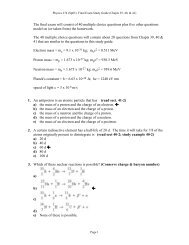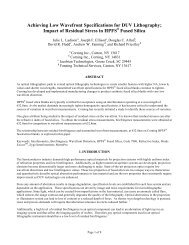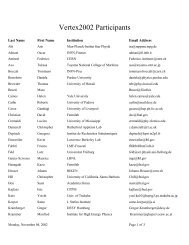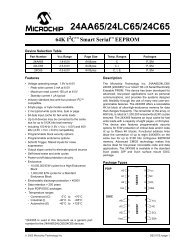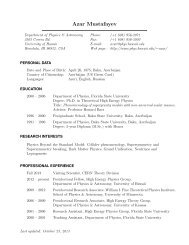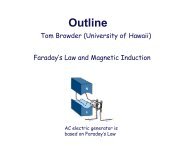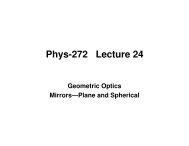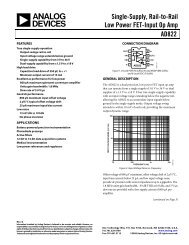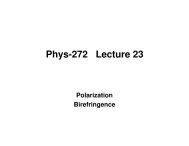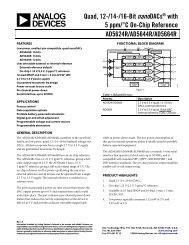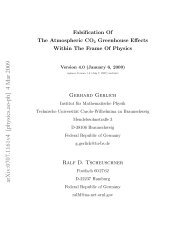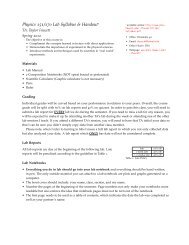RadFET Reader
RadFET Reader
RadFET Reader
Create successful ePaper yourself
Turn your PDF publications into a flip-book with our unique Google optimized e-Paper software.
<strong>RadFET</strong> <strong>Reader</strong><br />
By Larry Ruckman
What is a <strong>RadFET</strong>?<br />
• <strong>RadFET</strong> is an<br />
acronym for<br />
Radiation Sensitive<br />
MOSFET.<br />
• ZVN3306 is the<br />
Radiation Sensitive<br />
MOSFET that is<br />
being used in<br />
<strong>RadFET</strong>R<br />
ZVN3306<br />
SOT-23<br />
U.S. Dime
How Does It Work?<br />
Electric Field<br />
•Radiation induced a load on the silicon oxide part of the<br />
MOSFET
Type of Data<br />
Current<br />
Voltage
What is <strong>RadFET</strong>R going to<br />
be used for?<br />
• The <strong>RadFET</strong>R is going to replace the old<br />
<strong>RadFET</strong> sensors that are currently being<br />
used around the world right now.
Block Diagram of Single<br />
Sampling Channel
Plot of the Bias Current<br />
12<br />
10<br />
8<br />
6<br />
Voltage<br />
4<br />
2<br />
0<br />
0 20000 40000 60000 80000 100000 120000<br />
-2<br />
-4<br />
-6<br />
Resistances<br />
Actual values with additional external loads Expected line for 160 µA
Voltage Drop of<br />
a +8 Volt Sample
Voltage Drop of<br />
a +4 Volt Sample
Voltage Drop of<br />
a Zero Volt Sample
Voltage Drop of<br />
a +4 Volt Sample
…Then What is the<br />
Leakage Current???
Front Panel
Powering UP<br />
•Standard NIM BIN Connector<br />
•External DC Power Connector
2 Types of Triggering<br />
• Internal Triggering<br />
• External Triggering
Internal Triggering<br />
• The Internal<br />
triggering is activated<br />
through the CPLD<br />
CPLD
External<br />
Triggering<br />
• This LEMO<br />
connector allows the<br />
user to send an<br />
external trigger into<br />
the <strong>RadFET</strong>R. . A<br />
TTL level signal<br />
between +2 to +3.3<br />
volts is required to<br />
externally trigger the<br />
<strong>RadFET</strong>R.<br />
EXT TRIG
3 Types of Readout<br />
• FAO<br />
• Logger Output<br />
• Serial I/O
FAO Readout<br />
• The FAO is a LEMO connector that allows<br />
the user to probe the channel that is<br />
selected on the front panel selected<br />
channel. The FAO can be connected to a<br />
voltmeter or even an oscilloscope. This is a<br />
great way to measure the voltage without<br />
the <strong>RadFET</strong> Display. Remember that when<br />
taking readouts with the FAO that you are<br />
only measuring one single channel that has<br />
been selected.<br />
FAO
Logger Output<br />
Readout<br />
• The Logger Output is a 34 pin<br />
connector that sends a signal of the<br />
voltage of the channel that is being<br />
sampled. There is a convenient ground<br />
pin next to each signal pin. This type<br />
of read out only sends a signal of the<br />
channel that being Sampled.<br />
Logger Output
Serial I/O<br />
Readout<br />
• The Serial Readout is a great<br />
way of measure all 16 channels<br />
quickly and compactly. SAO (pin<br />
1) is the readout of pin. The<br />
amplitude of the signal is the<br />
voltage of channel. The signal<br />
goes in numerical order from<br />
channel 1 through channel 16.<br />
Timing references are provided<br />
to aid in using an external ADL.<br />
SATS1 is the enable signal which<br />
indicates that the serial output is<br />
active. SATS2 is a sample<br />
stroke signal which may be used<br />
to initiate an ADL conversion<br />
cycle.
An Example of Serial Readout
Serial Readout<br />
with Timing References
Characteristic<br />
Board Size<br />
? <strong>RadFET</strong>R <strong>RadFET</strong>R2<br />
Negative Power<br />
<strong>RadFET</strong>R<br />
7” X 7.125”<br />
-10 Volts<br />
RADFETR2<br />
8.25” X 7.125”<br />
-15 Volts<br />
5 Volt Regulator<br />
Heat Issue<br />
Voltage Rating on<br />
Cap 2.2µF<br />
LM7805CK Pin<br />
Numbering<br />
Overall Power<br />
Issues<br />
CPLD Firmware<br />
Voltage Regulator<br />
was Toasty<br />
16 Volts<br />
Error on pin<br />
numbering<br />
Sampling<br />
Problems<br />
Made room for a<br />
heat sink<br />
35 Volts<br />
Fixed<br />
Fixed
<strong>RadFET</strong>R2 Schedule<br />
• Receive <strong>RadFET</strong>R2 by August 16, 2004<br />
• By October 1, 2004 – have 5 working<br />
boards with covers.<br />
• By October 29, 2004 – have all 10<br />
boards working with covers.




